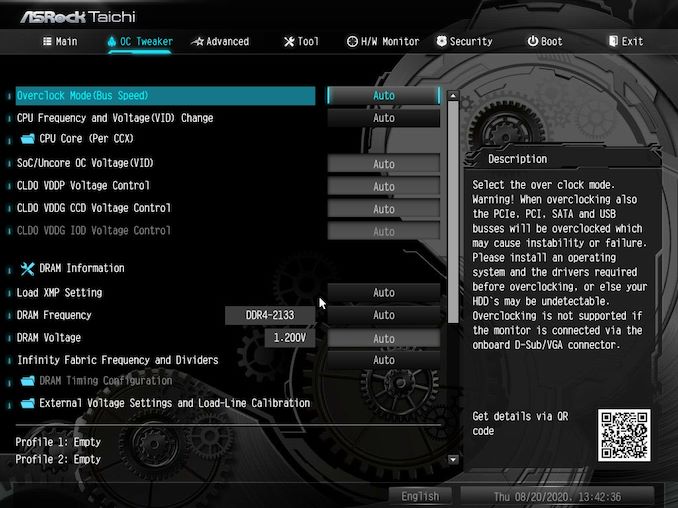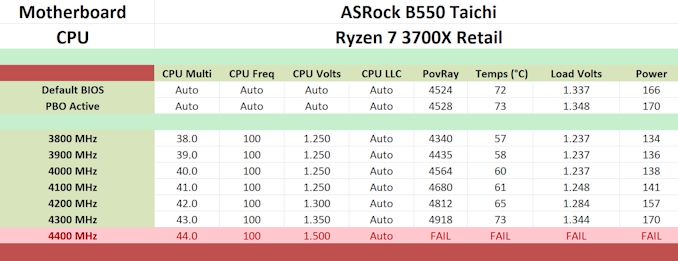ASRock B550 Taichi Review: The $300 B550 Motherboard with Chutzpah
by Gavin Bonshor on August 21, 2020 3:30 PM EST- Posted in
- Motherboards
- AMD
- ASRock
- Taichi
- AM4
- Ryzen 3000
- Ryzen 3700X
- Ryzen 4000
- B550
- B550 Taichi
Overclocking Ryzen 3000
Experience with the ASRock B550 Taichi
It's no secret that AMD's Ryzen 3000 processors run hot on basic air cooling thanks to the highly-dense cores packaged onto its 7 nm chiplets. For our testbed Ryzen 7 3700X processor with 8-cores and 16-threads, the key to unlocking the extra performance available with Ryzen 3000 is down to the cooling, with custom water cooling and good quality AIO coolers handling AMD's Precision Boost Overdrive a little better. Another way to squeeze out extra system performance is via the memory, although Ryzen 3000 works optimally with DDR4-3600, with an Infinity Fabric or FCLK clock speed of 1800 MHz. This is what most Ryzen 3000 silicon can manage without instability issues.
Using the ASRock B550 Taichi's firmware to overclock our Ryzen 7 3700X processor was straight forward. All of the boards overclocking settings are within the OC Tweaker setting and includes everything needed to overclock both the CPU and memory. Under the CPU frequency and Voltage (VID) change option, users can dial in a ratio in 100 MHz increments, eg 4.3 for 4.30 GHz. Underneath this is the option to change the CPU core frequency, although we find it best to remain under 1.45 V for the longevity of the silicon. The range of CPU core voltage also relies on the cooling method used, with better cooling allowing for sustained performance without the risk of thermally throttling the CPU cores.
Other important options include a dedicated section for customizing memory latencies, with extensive options available. For users looking to overclock memory to its rated specifications via X.M.P 2.0 profiles, they can simply select the relevant profile, although some memory kits sometimes come with more than one profile. Setting the Infinity Fabric Frequency is equally important, which we recommend stays below 1800 MHz and it works best at half the memory speed, eg, 1800 MHz on the FCLK for DDR4-3600, and 1600 MHz for DDR4-3200.
Overclocking Methodology
Our standard overclocking methodology is as follows. We select the automatic overclock options and test for stability with POV-Ray and OCCT to simulate high-end workloads. These stability tests aim to catch any immediate causes for memory or CPU errors.
For manual overclocks, based on the information gathered from the previous testing, starts off at a nominal voltage and CPU multiplier, and the multiplier is increased until the stability tests are failed. The CPU voltage is increased gradually until the stability tests are passed, and the process repeated until the motherboard reduces the multiplier automatically (due to safety protocol) or the CPU temperature reaches a stupidly high level (105ºC+). Our testbed is not in a case, which should push overclocks higher with fresher (cooler) air.
We overclock with the Ryzen 7 3700X, for consistency with our previous overclocking tests.
Overclocking Results
Performing our usual method of overclocking shows the ASRock B550 Taichi is a very capable motherboard for users looking to capitalize on AMD's unlocked AM4 series models such as B550 and X570. The default settings include AMD's Precision Boost Overdrive active so users are getting the best-case scenario without factoring in memory. The maximum stable overclock we managed to achieve with our Ryzen 7 3700X processor was 4.3 GHz at 1.350 V on the CPU VCore. This is equal to the best overclock we have managed on any AM4 model tested so far.
Overclocking manually from 3.8 to 4.3 GHz, we saw a gradual and expected increase in POV-Ray performance, with an equally expected increase in temperature as we increased the CPU VCore voltage. In regards to CPU Vcore voltage set manually in the firmware in comparison to CPU VCore under load, we found the B550 Taichi to have solid VDroop control with the Load-Line Calibration or LLC settings left at default. One benefit to the ASRock firmware is that it would under volt slightly which should slightly reduce temperature and power consumption, although the difference is marginal at best. We did try and achieve a maximum overclock of 4.4 GHz with 1.50 VCore to see if it would run, but this was unstable and is down to a limit of our silicon as opposed to the board itself.












61 Comments
View All Comments
dromoxen - Tuesday, August 25, 2020 - link
How do you connect your endpoints directly ? I would like 2.5gb for my next purch but lack of cheapish switches is a stumbling block ... 2500K needs retiring ..Or do I wait for ??Gigaplex - Wednesday, August 26, 2020 - link
My file server has 2 ethernet ports. I connect my desktop to my file server directly with an ethernet cable using the 2.5G port, and use the other ethernet port on the server to the rest of my network. The network connections are bridged on the server, so the desktop can see the rest of the network.Spunjji - Monday, August 24, 2020 - link
"Why 2.5GbE" - because some people keep their boards a long time, 1GbE is pretty slow for NAS storage needs and the kind of person spending $300 on a motherboard probably isn't going to use their ISP's router as their main switch?Most ISP routers aren't WiFi 6 yet either, so it's weird that you think *that* makes sense but not the 2.5GbE.
You've arbitrarily stated a "maximum price" for B550 that seems more appropriate for B520.
xrror - Monday, August 24, 2020 - link
Of all of the possible things to complain about, you pick having onboard 2.5GB NIC?I mean, it just seems a strange choice as a complaint?
TheinsanegamerN - Tuesday, August 25, 2020 - link
By that argument most motherboards shouldnt even have gigabit, but rather fast ethernet 100 Mbps.seamonkey79 - Sunday, August 23, 2020 - link
This is as stupid as paying $100 extra for a AIO with a screen on the waterblock.Greys - Wednesday, August 26, 2020 - link
CoolOxford Guy - Wednesday, August 26, 2020 - link
Yes, it’s cool to parlay a midrange chipset at a premium price point.Why? Who knows!
Everett F Sargent - Thursday, August 27, 2020 - link
"Yes, it’s cool to parlay a midrange chipset at a premium price point.Why? Who knows!"
Try this B550 board ...
https://www.gigabyte.com/Motherboard/B550-AORUS-MA...
If I wanted a 16-phase Voltage Regulator AND an MSRP below $300US ($280US) this looks like a pretty good option. I also am not into OC or gaming, so that I am fine with a very cheap graphics card running 8X and three M.2 PCIE 4.0 SSD's in RAID0 and a 3950X running stock. I'll also use ECC memory as this thing will be running all 32-threads 247 for weeks on end.
Plugin two (or one) additional PCIE 4.0 M.2's, the GPU is set to x8 instead of x16
So the question is, is there anything out there (AMD) that is available for a lower MSRP cost that has, at a minimum, a 16-phase Voltage Regulator? TIA
Oh and if you have a better solution for whatever reason(s) that would also be most useful.
I think the MB vendors know what they are doing, there appears to be no MSRP price overlap for comparable feature sets. Still trying to find an X570 that will do all that this MB can do at a lower MSRP price point.
I'm thinking of using this MB as a sort of test bed for my own numerical modelling codes (do I really need RAID 0 for I/O, RAM requirements and possibly some OC (depends on % improvement and temperatures, but gaining only a few percent seems to be rather pointless. which appears to be the current situation, I need more threads not a small % MHz improvement).
Oxford Guy - Tuesday, September 1, 2020 - link
I already said the VRM marketing pitch falls flat because these CPUs shouldn't even be overclocked.It's a gimmick and it flunks.